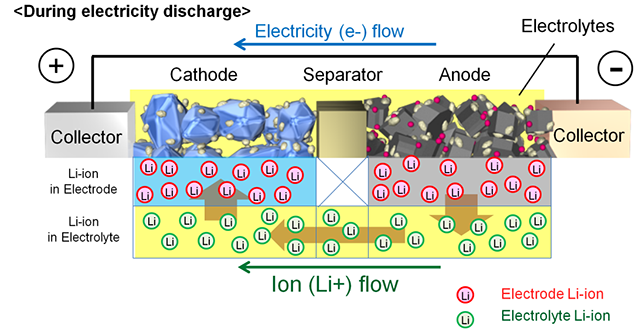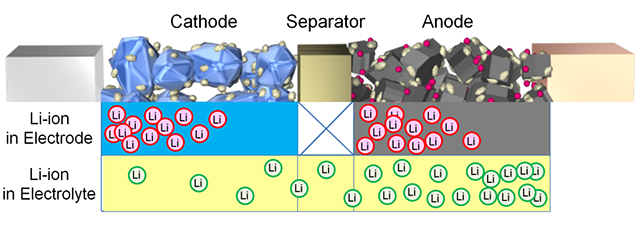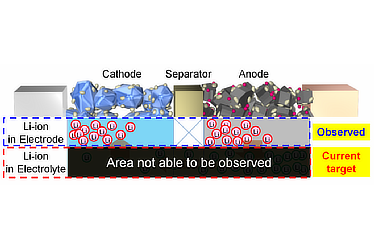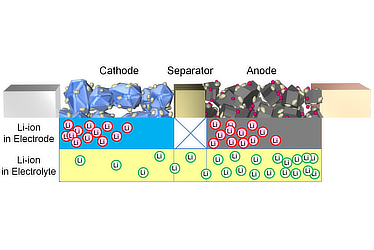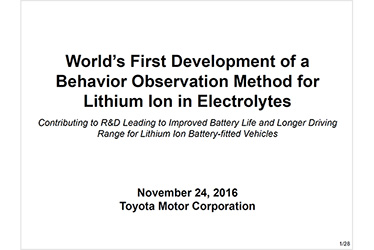Nov. 24, 2016
Toyota Develops World's First Behavior Observation Method
for Lithium Ions in Electrolyte
Breakthrough Contributes to R&D that will Lead to Longer Battery Life and Longer Driving Range for Vehicles Using Lithium ion Batteries
Toyota City, Japan, November 24, 2016―Toyota Motor Corporation has developed the world's first1 method for observing the behavior of lithium ions (Li-ions) in an electrolyte when a Li-ion battery charges and discharges.
By using this method, it is possible to observe in real-time, the deviation of Li-ions―one of the causes of deterioration in the performance of Li-ion batteries. Toyota believes that this will provide essential guidelines for R&D that aims to improve the performance and durability of batteries, which would lead to longer battery life, as well as longer driving ranges for plug-in hybrid vehicles (PHVs) and electric vehicles (EVs).
Li-ion batteries use a metal oxide in the cathode, a carbon material in the anode, and an organic electrolyte for the electrolyte. Lithium ions flow in the electrolyte from the cathode to the anode when the battery is charging, and from the anode to the cathode when the battery is discharging, which results in an electric current flow. Thus, the Li-ions play an essential role within the electrolyte during battery charging and discharging.
It has been known that Li-ion deviation occurs in the electrodes and electrolyte as a result of charging and discharging, and such deviation has been believed to limit the usage area of batteries, which is one factor that reduces the area in which the maximum performance of the battery can be achieved. When investigating the mechanism of Li-ion deviation, however, confirming the behavior of Li-ions in the electrolyte under the same environment and conditions as when it is being used in related products was not possible using existing methods.
The two main features of the observation method that Toyota developed to help solve this problem are as follows:
- The Toyota Beamline2 in the SPring-83 synchrotron radiation facility, which generates the world's highest-performance synchrotron radiation, produces high-intensity X-rays that are approximately 1 billion times more powerful than those generated by an X-ray equipment. This makes it possible to create 0.65 micron/pixel high-resolution and 100 ms/frame high-speed measurements.
- In place of the electrolyte with phosphorous that is used in many Li-ion batteries, a new electrolyte with heavy elements is being utilized instead, thus replacing the phosphorous-containing ions that the Li-ions bind to as they move in the electrolyte with heavy element-containing ions. Heavy elements transmit less of the X-rays than phosphorous, and the shadows on the images taken after the X-rays pass through are darker. By observing the behavior of the heavy elements, it is possible to observe the deviation behavior of the Li-ions which are bound to them in the electrolyte.
By using the method described above, and a battery that is similar to that of related products such as laminated cell under the environment and conditions that resemble those of actual battery use, it is possible to observe in real-time, the process of Li-ion deviation that occurs in electrolytes during the course of battery charging and discharging. This observational method was jointly developed by Toyota Central R&D Labs, Inc., Nippon Soken, Inc., and four universities.4
Going forward, Toyota will observe the behavior of Li-ions caused by differences in the materials and structures of cathodes, anodes, separators, and electrolytes, as well as the differences in battery control. Analyzing the mechanisms that cause deterioration of battery performance will lead to R&D that can help to improve the performance and durability of batteries, to bring about longer battery life and longer driving ranges.
1Methods for observing laminated cells by using high-intensity X-rays and incorporating heavy elements into an electrolyte (According to Toyota Motor Corporation, as of August 2016)
2Installed as a special-purpose beamline by Toyota Central R&D Labs, Inc. with the Cooperation of the Institute of Physical and Chemical Research (RIKEN) and the Japan Synchrotron Radiation Research Institute (JASRI).
3A testing and research facility with the world's highest performance synchrotron radiation comprehensively operated by RIKEN as the facility owner. Operated and maintained by the Japan Synchrotron Radiation Research Institute (JASRI). SPring-8 stands for Super Photon ring-8 GeV.
4Hokkaido University, Tohoku University, Kyoto University, and Ritsumeikan University.




